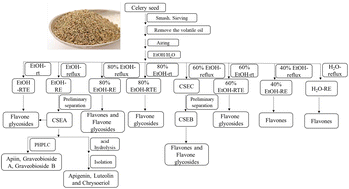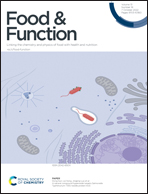Extraction optimization, structural characterization and potential alleviation of hyperuricemia by flavone glycosides from celery seeds†
Abstract
Celery seeds are commonly used as condiments and in herbal teas with high medicinal value. In the present study, we investigated the contents of extracts derived under different extraction conditions and determined the optimal conditions for only extracting flavone glycosides from celery seeds. The compositional analysis identified three primary flavone glycosides in the ethanolic extract, and apiin, graveobioside A, and graveobioside B were isolated. Apigenin, luteolin, and chrsyeriol were obtained by the acid hydrolysis of flavone glycosides under high-temperature conditions. Here we investigated the inhibitory activity of apigenin and apiin on xanthine oxidase by reducing the rate of oxidative cytochrome C and found that both apigenin and apiin reduced cytochrome C production, except for low concentrations of apiin. In vivo analysis with hyperuricemia mice and rats showed that apiin had excellent uric acid-lowering effects and high dose-dependence, while apigenin was relatively slightly uric acid-lowering. In addition, the flavone glycoside extracts from celery seeds exhibited similar effects of reducing uric acid with apiin. Surprisingly, in hyperuricemia rats, the uric acid-lowering effects of high-dose apiin and flavone glycoside extracts were almost comparable to that of allopurinol. Besides, our experimental results showed that apigenin could improve uric acid clearance by increasing the glomerular filtration capacity, which was reflected in reducing the renal function parameters SUN and SCr; also, apiin showed better results. This study also showed that celery seeds have a unique medicinal value in treating hyperuricemia and that the flavone glycoside extracts from celery seeds can be developed as medicine for hyperuricemia.



 Please wait while we load your content...
Please wait while we load your content...